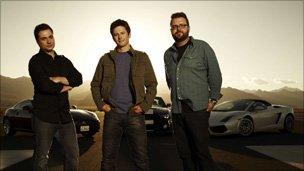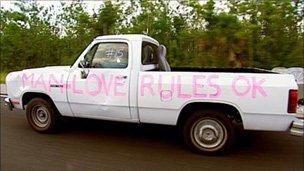Top Gear USA: Will it work without Jeremy Clarkson?
- Published
A clip from the new US Top Gear
Will the US version of the British TV motoring show Top Gear be as successful as the Emmy-winning original?
It is the latest in a long line of British shows to try crossing the Atlantic, some of which have become big hits. The success of American Idol and America's Got Talent have made judges Simon Cowell and Piers Morgan into household names.
But Top Gear has been reincarnated in the US without any of its British presenters - Jeremy Clarkson, Richard Hammond and James May - whose laddish antics and irreverent humour are such a big part of its appeal.
"For this to be Jeremy's love child and for us to get the opportunity to present the show is amazing," says Rutledge Wood, one of the trio of US presenters.
"It's like we're dating his sister."
When Wood and co-presenters Adam Ferrara and Tanner Foust got a letter from the sharp-tongued Clarkson - who has said American focus groups "just don't get" the programme - they were understandably nervous.
Luckily the letter was positive: "He watched it with Hammond and May, and said well done to all concerned - it was really nice," says Adam.
Helicopter race
After a handful of episodes, much discussion of the show centres on whether the US presenters have got what it takes. The British version of Top Gear, shown on BBC America, has a cult following in the US already, and some think the homegrown team is disappointing.
"I tried to watch it and sadly this show does not have the spark," writes one viewer on the official Top Gear website.
Another says: "This copy of the UK program is inferior and unworthy of the name Top Gear. Maybe Bottom Gear would be a better name!"

The US trio say they're not trying to emulate Clarkson and co.
But another section of the audience argues for the show, and its presenters, to be given time to find their feet.
Many of the stunts appear to have gone down well. In three of the first four episodes, cars were raced against a Cobra attack helicopter, downhill skiers and a high altitude parachutist.
The hosts have competed against each other - and against a blind man - at "drifting" (making a car skid and spin). They have also undertaken challenges in cars bought for less than $1,000 (£647).
Guest drivers, in a segment named Big Star, Small Car (instead of Star in a Reasonably Priced Car) have included retired astronaut Buzz Aldrin, the slowest round the test circuit, and skateboard star Tony Hawk.
And of course, there is the Stig - the anonymous, permanently helmeted racing driver - who races cars around the programme's own test circuit.
Americanisation
Creating a US version of Top Gear made sense because there was a gap in the market for a smart and fun show focused on the US car industry, says Dave McKillick, a senior vice-president at the History Channel, on which the show is being screened.
"It's about satisfying the obsession Americans have with cars," he says.
Watch clips of the Russian and Australian versions of Top Gear
For his part, executive producer John Hesling says he chose the presenters because they were "representative of different car cultures in the United States".
Adam Ferrara is a comedian and actor from New York.
Tanner Foust, a professional stunt driver, is from the West coast and loves foreign cars.
Rutledge Wood is from the South and is obsessed with Nascar (stock car racing).
And unlike the British show, which visits America occasionally, Top Gear USA is on the ground all the time. The test circuit is in Irvine, California. The challenges have taken place across the country, on different terrains, from Alaska to North Carolina.
Another big difference is that the original Top Gear is wholly funded by the BBC, whereas Top Gear USA relies predominantly on advertising - from the motor industry.
It's one reason that the comedian and TV presenter Jay Leno turned down an offer to front an earlier pilot for the NBC channel.
"My great fear in America is that, for instance, if Kia was our sponsor this week, we'd have to say the car was fantastic," he wrote in the Sunday Times.
That was also a concern felt by actor and racing driver Bruno Massel, who ended up fronting the earlier NBC pilot. "You didn't want to insult anybody or put a product down, there was a concern about alienating the companies," he said.
Mr Hesling denies that this issue is causing any punches to be pulled on a show that he insists will remain "honest and credible".
"Every show has to have good things and bad things," he says. One reason it ended up on the cable channel, History, he explains, was because executives there agreed this was an important part of the show's character.
Humour
Another reason a US version of the show was considered important, is the difference between British and American humour.
According to TV critic Brian Lowry from Variety magazine, humour is "probably the most culturally specific genre", and makes a show like Top Gear tougher to export to the US than reality TV or a talent show.
John Hesling, who is British-born, says British humour is "unique".

Richard Hammond tempted residents of Alabama to shoot, with this pink slogan
"Regional differences, the class system - they enable you to make jokes within jokes," he says.
Cliches about Skodas and Volvo drivers that you'll hear on the British Top Gear are replaced with references that mean more to American viewers.
"They'll say a Mini Cooper will only be driven by a middle-aged man with an over controlling wife, or that a BMW 3 series is only driven by rich teenage girls," he says.
The British version of Top Gear also enjoys the odd joke at America's expense - for example, by travelling across Alabama in vehicles sprayed with slogans designed to test the patience of the locals, such as "Country and Western is Rubbish" and "Man Love Rules OK". This, and Clarkson's general mockery of American cars, probably isn't the best way to maximise viewing figures in the US.
Rutledge Wood, meanwhile, has already succeeded in getting in some jabs at Brits. In episode two of Top Gear USA he tested two Aston Martins, neither of which could reach the fastest speed indicated on the speedometer, external. "Liars, all of these Brits are liars!" he joked.
That is one luxury of having two different versions of the show. Audiences on both sides of the Atlantic get the chance to feel superior.
- Published14 December 2010